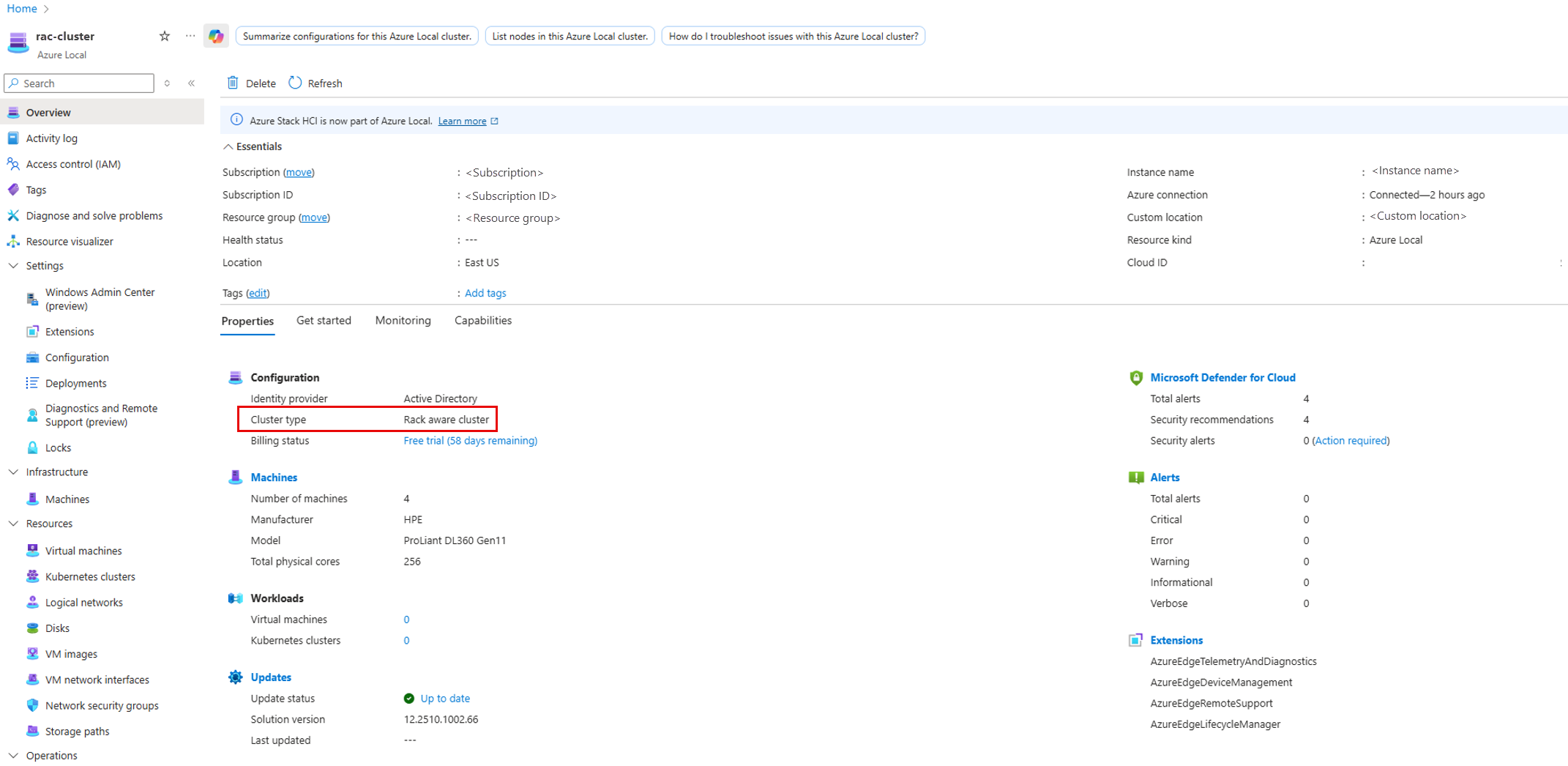Note
Access to this page requires authorization. You can try signing in or changing directories.
Access to this page requires authorization. You can try changing directories.
Applies to: Azure Local version 2510 and later
After deploying rack aware cluster, either through the Azure portal or using the Azure Resource Manager deployment template, you need to complete a set of post-deployments tasks. This article describes the typical tasks required once your rack aware cluster is successfully deployed and all machines are up and running.
Important
This feature is currently in PREVIEW. See the Supplemental Terms of Use for Microsoft Azure Previews for legal terms that apply to Azure features that are in beta, preview, or otherwise not yet released into general availability.
Verify cluster status
Follow these steps to check the status of your cluster:
- In the Azure portal, go to the Overview page of your Azure Local resource.
- On the Properties tab, under Configurations, review the Cluster type value:
Verify machines status
Follow these steps to check the status of machines in your cluster:
In the Azure portal, go to your Azure Local resource page.
Under Infrastructure, select Machines.
Verify that the machines are grouped by local availability zone.
(Optional) Change the quorum witness to a local witness
By default, rack aware cluster uses a cloud witness. If your configuration requires it, you can change it to a local witness. For more information, see Deploy a quorum witness.
(Optional) Create workload volumes
For 2+2 and larger rack aware cluster configurations, deployment via the Azure portal supports only Express mode. In this mode, infrastructure components, workload volumes, and storage paths are automatically created for each volume.
Here's is a sample output from a 4+4 rack aware cluster:
If you want to create custom workload volumes instead of those created during cluster deployment, you can create either 2-way or 4-way mirror volumes, using either fixed or thin provisioning. Before adding the new volumes, you must delete the existing storage paths and volumes.
After creating new workload volumes, you must create storage paths for the new volumes. For detailed instructions, see Create storage path for Azure Local.
#Create a four-copy volume on the storage pool, fixed provisioned:
New-Volume -FriendlyName “FourCopyVolumeFixed” -StoragePoolFriendlyName "SU1_Pool" -FileSystem CSVFS_ReFS -Size 500GB -ResiliencySettingName Mirror -PhysicalDiskRedundancy 3 -ProvisioningType Fixed
#Create a four-copy volume on the storage pool, thinly provisioned:
New-Volume -FriendlyName “FourCopyVolumeThin” -StoragePoolFriendlyName "SU1_Pool" -FileSystem CSVFS_ReFS -Size 500GB -ResiliencySettingName Mirror -PhysicalDiskRedundancy 3 -ProvisioningType Thin
#Create a two-copy volume on the storage pool, fixed provisioned:
New-Volume -FriendlyName “TwoCopyVolumeFixed” -StoragePoolFriendlyName "SU1_Pool" -FileSystem CSVFS_ReFS -Size 500GB -ResiliencySettingName Mirror -PhysicalDiskRedundancy 1 -ProvisioningType Fixed
#Create a two-copy volume on the storage pool, thinly provisioned:
New-Volume -FriendlyName “TwoCopyVolumeThin” -StoragePoolFriendlyName "SU1_Pool" -FileSystem CSVFS_ReFS -Size 500GB -ResiliencySettingName Mirror -PhysicalDiskRedundancy 1 -ProvisioningType Thin
Validate the volumes
To verify if the volume is configured as Rack Level Nested Mirror (RLNM), use the following command:
spaceutil get-space -name <volume name>
This command returns details about the volume, including the NestedFdType and MaxFdType parameters.
The following table shows the expected output for each configuration:
| Configuration | Output |
|---|---|
| 4-way mirror with RLNM | NestedFdType: NodeMaxFdType: Rack |
| 2-way mirror with RLNM | NestedFdType: UnknownMaxFdType: Rack |
| No RLNM, Storage domain is set to RACK | NestedFdType: (null)MaxFdType: Rack |
Here's a sample output from a volume with RLNM 4-way mirror enabled:
spaceutil get-space -name userstorage_1
Id : <ID>>
PoolId : <PoolID>>
Name : UserStorage_1
Description : ASProtected;ASUser;
Usage : Data
DeviceNumber : -1
InstancePath : (null)
Health : Unknown
OperationalState : Detached
IsManualAttach : True
IsClustered : True
Priority : 5
DetachReason : Policy
ProvisionedCapacity : 4.30 TB
AllocatedCapacity : 38.0 GB
FootprintOnPool : 152 GB
Security : O:BAG:SYD:(A;;FX;;;WD)(A;;FA;;;SY)(A;;FA;;;BA)
ProvisioningType : Thin
AllocationSize : 256 MB
MediaType : Unknown
MinFdType : Drive
NestedFdType : Node
MaxFdType : Rack
ScopeType : Unknown
NumberOfScopes : 0
NumberOfMetadataDrives : 0
ResiliencyType : Mirror
FaultTolerance : 3
NumberOfCopies : 4
NumberOfGroups : 1
NumberOfColumns : 8
Interleave : 256 KB
WriteCacheSize : 0
WriteCacheReserveSize : 0
ReadCacheSize : 0
MinimumLogicalCopies : 1
IsTiered : False
Flags :
SnapshotId :
ReserveId :
MaxIops : 0
MaxIoBandwidth : 0


